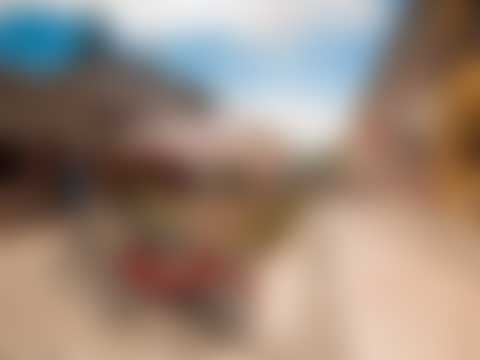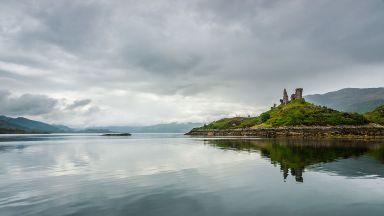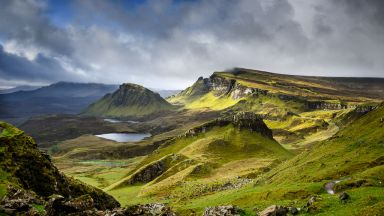Glenfinnan Monument
Monument, Viewing Point and Visitor Centre in Lochaber and Fort William

By 1815, the Jacobite cause was no longer a political threat to the Hanoverian monarchy. Alexander Macdonald of Glenaladale, a minor branch of the Clan Donald, built a memorial tower at Glenfinnan to commemorate the raising of the standard of the Young Pretender. The tower, which is 18 metres in height, was designed by the Scottish architect James Gillespie Graham. The statue of an anonymous highlander, referred to at the point of commission as Charles Edward Stewart, by John Greenshields, was added in 1835.
Where is the Glenfinnan Monument Located?
The iconic Glenfinnan Monument stands at the head of Loch Shiel, framed by the hills and woods of Moidart, Ardgour and Lochaber.
Who Erected the Glenfinnan Monument?
The Monument was erected in 1815 by Alexander MacDonald of Glenaladale as a tribute to the loyal Jacobites who rallied behind Bonnie Prince Charlie in his attempt to regain the British crown for the Stuarts in the 1745 uprising.
Why was the Glenfinnan Monument built?
Glenfinnan Monument was erected in 1815, in tribute to the Jacobite clansmen who fought and died in the cause of Prince Charles Edward Stuart.
On Monday 19 August 1745 a small rowing boat landed at the north end of Loch Shiel. It was early afternoon. Prince Charles Edward Stuart, “Bonnie Prince Charlie” came ashore and raised his Standard (a banner of red and white silk, reputed to have been sewn by the women of nearby Dalilea). Accompanying him were the Seven Men of Moidart: four Irishmen, two Scots and one Englishman. They were met by an escort of of Highland chiefs and clans of MacDonalds (including Clanranald, Morar and Keppoch) and Camerons of Lochiel. On September 17, with about 2,400 men, he entered Edinburgh. Four days later he routed Sir John Cope’s army at Prestonpans, near Edinburgh; early in November, with 5,500 men, he crossed the English border and headed toward London. Charles advanced as far as Derby before his officers, discouraged by lack of French and English support and frightened by the prospect of facing 30,000 government troops, forced him to retreat into Scotland. His troops melted away, and on April 16, 1746, William Augustus, duke of Cumberland, decisively defeated him at Culloden Moor, Inverness-shire. For the next five months Charles was relentlessly pursued by British soldiers. Finally, helped by loyal supporters (in particular, Flora Macdonald, he escaped by ship to France (September 1746).
What does the Glenfinnan Monument look like?
The Monument is built of rubble masonry, circular with a basal diameter of 4 metres and extending to a height of 18.3 metres. Architectural features include a Tudor Gothic doorway, a spiral stairway, narrow slit windows, an external platform and the statue of a Highlander (the latter added in 1830). It was originally enclosed by a low wall, which was later replaced by a more ornate, octagonal faceted perimeter wall. The tower was originally joined to a two-storey bothy ( the ‘shooting box’); this was later removed by Angus MacDonald, the son of the original patron of the Monument during restoration work.
The perimeter wall supports three cast iron commemorative panels in parallel scripts of Gaelic, Latin and English on the outside and a marble panel on the inside. The marble panel commemorates those lost in the Jacobite Cause and the patron of the Monument, Alexander MacDonald, who died in the year of its completion The perimeter wall encloses a small open space with benches around the edges and an interesting collection of emblematic plants representing the supporting clans. Clan plants were worn as badges on bonnets to identify Clan affiliation. A white rose was reputed to have been picked by Bonnie Prince Charles at Fassfern House on the banks o Loch Eil and pinned to his blue bonnet. The white cockade (a knotted white ribbon or cloth) became a symbol of allegiance to the Jacobite cause.
Climbing to the top of the Glenfinnan Monument
If you are able bodied, it is well worth climbing to the top of the Monument, but note that he tower is described as unsuitable for the infirmed and those with a poor sense of balance. Considerable care is required in climbing the stone, spirally arranged, uneven steps and the platform is entered through a small open hatch.
The views are spectacular from the platform, with views across Loch Shiel and the surrounding hills to the west, to the Lochaber hills and Glenfinnan Viaduct to the east, to the pine forest and hills of Ardgour to the south and to St Finnan’s Church and the Glenfinnan Hotel to the north. The statute of the Highlander (possible representing Bonnie Prince Charlie) is impressive in its full Highland dress and encrusted with yellow, brown, green and oranges crustiose lichens. The Highland dress and tartan was later to be outlawed on account of its affiliation with the 1745 Uprising.
Glenfinnan Monument Visitor Centre
The National Trust for Scotland Visitor Centre contains a gift shop, café and an exhibition centre. In the Visitor Centre are displays and an audio programme about the Prince’s campaign from Glenfinnan to Derby and back to the final defeat at Culloden. The modern exhibition in the visitor centre tells the story of Prince Charles Edward Stuart and the 1745 Jacobite Rising.
The Glenfinnan Monument appears in our Complete Guide to Visiting Lochaber and Fort William!
This website uses affiliate links which may earn a commission at no additional cost to you!
Visiting Glenfinnan Monument
Glenfinnan Visitor Centre and Monument View Carpark
2 Jan–3 Apr, daily, 10.00–16.00
Current period4 Apr–4 Nov, daily, 10.00–17.00
5 Nov–23 Dec, daily, 10.00–16.00
24–26 Dec, closed
27 Dec–30 Dec, daily, 10.00–16.00
31 Dec–1 Jan 2023, closed
Monument: Adult £5, Chile £3, Car Park: £3.5 Views of Viaduct: Free!
Nearby Attractions
- Glenfinnan Viaduct (0.2) km
Aqueduct in Lochaber and Fort William - Armadale Castle, Gardens & Museum of the Isles (35.8) km
Castle, Gardens and Museum in Isle of Skye - Caisteal Chamuis (Knock Castle) (36.6) km
Castle in Isle of Skye - Dunscaith Castle (44.1) km
Castle in Isle of Skye - Eilean Donan Castle (45.2) km
Castle in Wester Ross - Tobermory Lighthouse (46.1) km
Lighthouse in Isle of Mull - Tobermory (47.4) km
Town in Isle of Mull - Tobermory Distillery (47.5) km
Distillery in Isle of Mull - Duart Castle (47.8) km
Castle in Isle of Mull - Caisteal Maol (48.0) km
Castle in Isle of Skye


